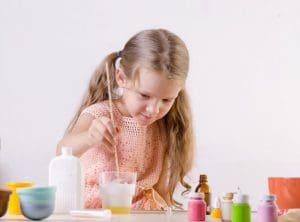 In our last quarantine activity article we discussed fun and easy ways to both entertain and incorporate science into your child’s daily home-schooling routine. Today we’re going to discuss some more great activities, but this time, they’re edible!
In our last quarantine activity article we discussed fun and easy ways to both entertain and incorporate science into your child’s daily home-schooling routine. Today we’re going to discuss some more great activities, but this time, they’re edible!
1). Shake up Some Butter
An educational AND delicious activity (not to mention a decent arm workout) your kids will undoubtedly be amazed by how easy it is to whip up some homemade butter!
Materials:
- Container with a tight sealing lid
- Heavy Cream
The amount of cream you pour in will determine how much butter you end up with but the amount of time you have to shake, shake, shake will still be roughly 25-30 minutes. If you have one of those fun little soccer ball ice cream makers, try using one of those instead!
Cream turns to butter due to shaking up the fat molecules within. This process displaces them from the liquid (which we call buttermilk) and eventually they stick together to form butter!
2). Pudding Slime
Hang on, hear me out! I promise this is nothing like that horrible gooey mess our kids obsess over.
The end result is more like a fluffier play-doh that smells amazing, is super easy to make and doesn’t taste too bad!
Materials:
- 1/4 cup Instant Pudding Mix
- 1 cup Corn Starch
- 1/3 cup Warm Water
Just combine all the ingredients in a bowl and mix it up! If it’s too wet just add small amounts of corn starch until it has the desired consistency, then enjoy!
3). Edible Stained Glass
This activity not only produces really cool results, but you can get pretty artsy too!
All you need to make edible glass are transparent hard candies, like life savers or jolly ranchers.
Place a bunch of different candies in a plastic bag and crush them up until it resembles sand. Then place the crushed candy onto a baking sheet covered in wax paper (I personally prefer my Silpat mats for this) and bake at 300 degrees until fully melted. When they cool off, you’ll be left with a gorgeous piece of edible glass!
To get creative, separate the colors and draw a picture on the baking sheet prior to baking. You can even use metal cookie cutters to produce shapes!
This experiment is a great way to teach kids how actual glass is made by heating up sand to extremely hot temperatures until it melts and becomes glass.
4). Grape Sculptures
A fantastic way to insert some Physics and Engineering into your home-schooling long before they probably even know what those words really mean!
All you need for this activity are grapes and toothpicks. Have your child build a structure using only those two items and challenge them to see how big they can get it!
If they’re more the creative type, allow them to design to their heart’s content and then use the final products for shadow sketches! Just place them in a sunny area and allow the grape and toothpick statue to cast a shadow onto a piece of paper for your child to trace.
5). Rock Cycle
A super easy way to teach your kids how each of the three different types of rocks are formed!
Materials:
- Starburst Candy
- Wax Paper
- Aluminum Foil
First up, Sedimentary rocks! Because sedimentary rocks are formed by pressure, for this step you’ll stack three different colored candies on top of one another. Wrap with wax paper and have your children press down on them, or step on them if they’re not strong enough. Allow your child to observe how the layers are now all connected but are compacted into neat individual layers that aren’t mixed together.
Second, Metamorphic! In nature, metamorphic rocks are produced by a combination of pressure and extreme heat. Like last time, stack three different colored candies and wrap in wax paper, but this time we’re going to heat them at 300 degrees for seven minutes. Once the foil is cool enough to touch, unwrap and have your child apply pressure to the wax paper. Have them compare the final product to the Sedimentary rock step!
Finally, Igneous rock! This type of stone is produce by exposure to extremely high temperatures and then being allowed to cool once again. Similarly to the process for making our Metamorphic experiment, heat the candies in the oven, except increase the time to 10 minutes. This should allow enough time for the candies to melt (but not burn). Once cooled, have your child record their observations about the change in appearance over the three different processes.
Do you have any fun edible science experiment ideas to share? Head over to our Facebook page and comment with your suggestion!
